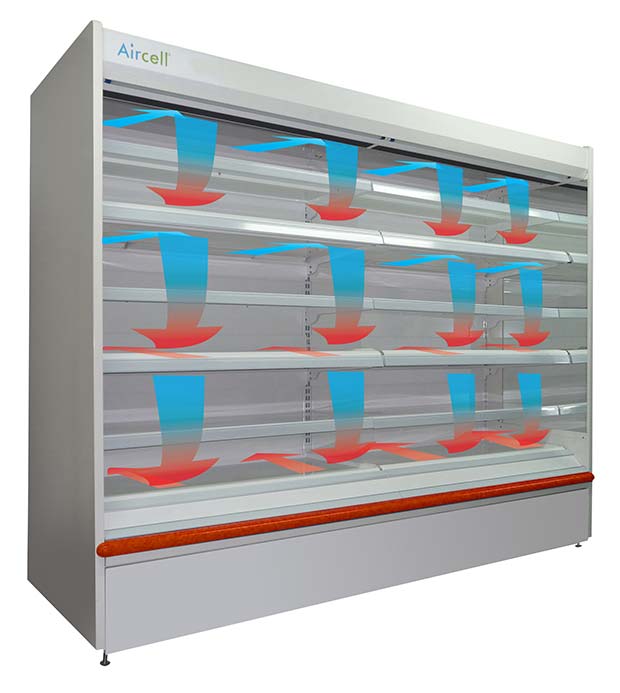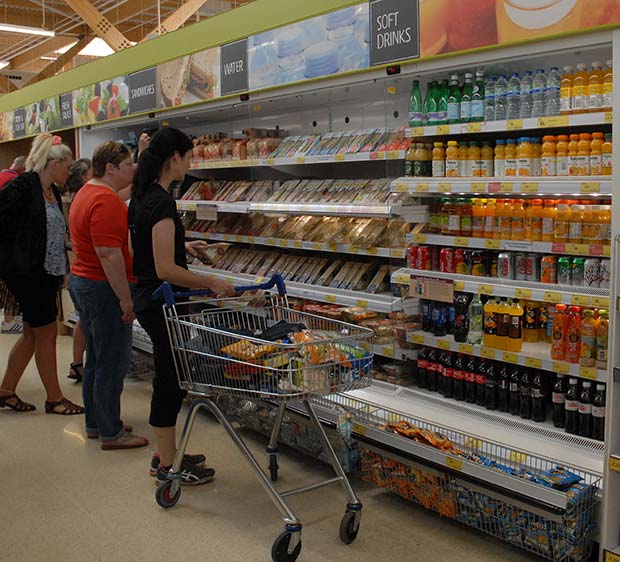Adande Refrigeration’s Managing Director, Ian Wood, is widely acknowledged as a leading innovator in the refrigeration sector. Ian shares his wealth of industry experience and explains how OEMs must develop the design and manufacture of refrigerated displays to accommodate the changing needs of food retailers.

Director, Ian Wood
For decades the open front multi deck has been retailers’ preferred solution for the display of chilled food. It provides ease of access for the shopper for browsing and shopping, whilst facilitating simple restocking for supermarket employees. The open front multi deck also affords maximum visibility of product, which together with creative merchandising, promotes impulse purchases.
The main problem associated with the design of the open front multi deck is that it features a single air curtain at the front of the case. Dense cold air sinks to the bottom of the cabinet, building pressure on the air curtain, causing cold air spillage and the infiltration of warmer ambient air. To replenish chilled air within the cabinet and restore the appropriate operating temperature, the refrigeration system is forced to work harder, increasing energy consumption and raising operating costs. With refrigeration accounting for up to 50% of a supermarket’s electricity usage and energy costs continuing to rise, retailers are understandably keen to explore technology which will reduce consumption.

merchandising envelope into separate air
flow managed cells with low pressure air
columns
Constant cold air spillage has significant implications for accurate and stable temperatures within the cabinet, which in turn, has consequences for the shelf life, appearance and food safety of perishable merchandise. For example, a temperature range of – 1°C to +7°C (M2) is accepted as safe and suitable for the display of dairy product, convenience food and chilled snacks. Temperatures below that range offer the potential for ice crystal formation and higher temperatures will lead to bacterial proliferation. In short, food held within an accurate and stable temperature bandwidth will be maintained at better quality for longer, leading to a more enjoyable product for the customer and less merchandise price discounted or thrown away due to deterioration in quality or appearance.
The outflow of chilled air from cabinets also promotes cold aisle syndrome, which is the chilly and often uncomfortable temperature experienced by shoppers and staff in the refrigerated departments of supermarkets. Many retailers recognise that cold aisle syndrome can compromise the shopping experience and, during seasonal cold periods, operate costly heating regimes and cold air retrieval systems to temper the chill factor.
In an attempt to offset cabinet cold air spillage, some OEMs and retailers have trialled refrigerated display cabinets with glass or perspex, hinged or sliding doors. Doors are undoubtedly a solution for low footfall stores where the doors are opened infrequently, but they are inappropriate for busy supermarkets with frequent openings. Our tests have demonstrated that glass door cabinets designed for up to 10 openings per hour experience significant loss of temperature control at an opening frequency of 30 or more per hour. Doors can have a negative impact on the visibility of merchandise and act as a physical barrier to shopping.
There are also cleaning and maintenance issues associated with doors on cabinets, which increase operational costs.
The ‘holy grail’ for supermarket retailers is a refrigerated display, which eliminates cold air spillage to reduce energy, ensure stable and accurate temperatures and temper the effect of cold aisle syndrome, whilst at the same time providing maximum visibility of merchandise and unfettered cabinet access for browsing, shopping and restocking. Hitherto, such a refrigerated display system has not been available.
At Adande, we have adopted a holistic approach to meeting all of the retailer focused requirements, by overcoming the fundamental flaw of open deck multi deck cabinets – the single air curtain, which causes cold air spillage. Our solution is Aircell, which works by dividing the refrigerated display case’s merchandising envelope into separate air flow managed cells with small, low pressure air columns. Each cell has its own air curtain, which is more efficient than a full case height air curtain on a conventional multi deck case.

air spillage, yet provides unfettered cabinet access.
The net result is less pressure on the inside of the air curtain of each cell and a substantial reduction in cold air spillage from the case. This helps maintain tighter temperature bandwidths, reduce energy consumption by up to 30% and temper the effect of cold aisle syndrome. Unlike conventional open front cabinets, Aircell does not require back panel flow to support the air curtain, so it does not over cool and freeze food at the rear of the cabinet. It is particularly suited to harsh environments, such as stores with cross draughts and higher ambient conditions, which have a detrimental effect on the performance of conventional cabinets.
Inevitably, there will be room for more than one type of refrigerated display, to meet retailer focused requirements, even within the same store. Understanding trading volumes and specific merchandising objectives will help with the specification of the most appropriate solution. Glass door cabinets are suitable for retailing areas with minimum footfall and low sales, whilst conventional open front multi decks will continue to be the answer for operations where merchandising flexibility and frequent changes to shelving configurations are required. Aircell provides all of the advantages of the shopper friendly open front multi deck and is particularly suited for areas with high traffic and large volume sales, whilst delivering significant energy savings, tighter holding temperatures and a more comfortable shopping experience.
ADANDE® REFRIGERATION
Tel: 0844 376 0023
Email: info@adande.com




Comments are closed.